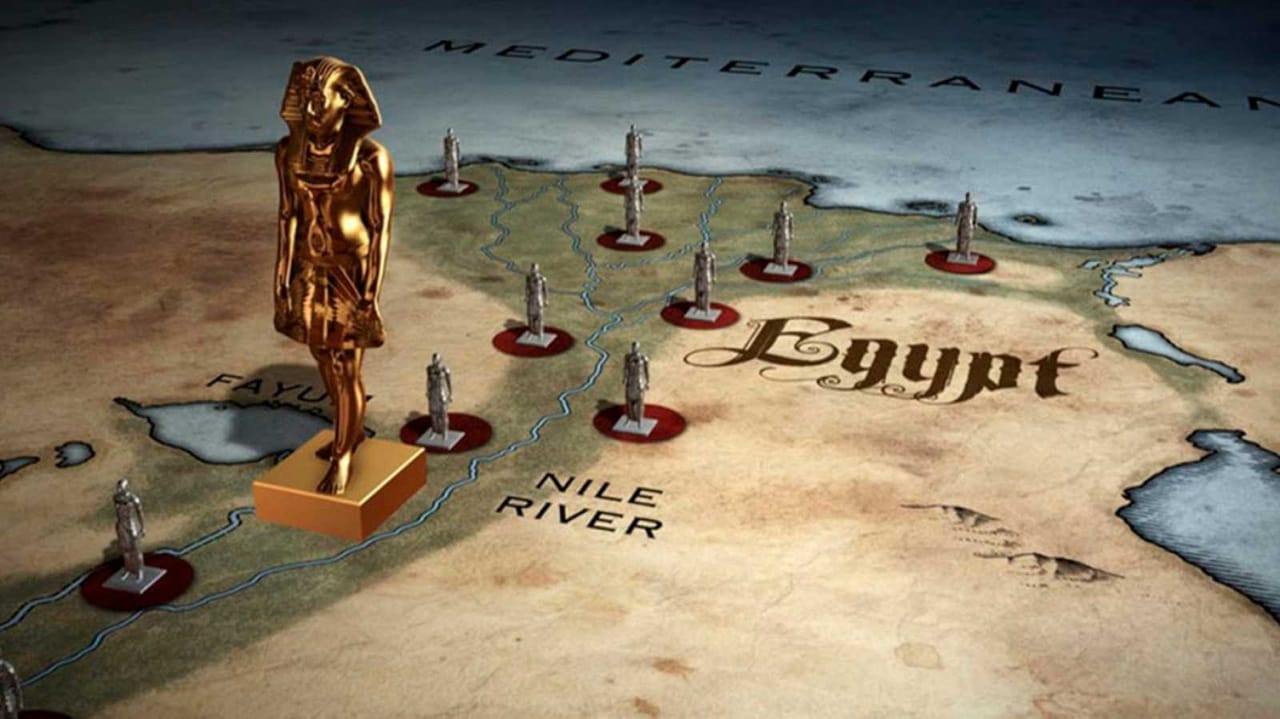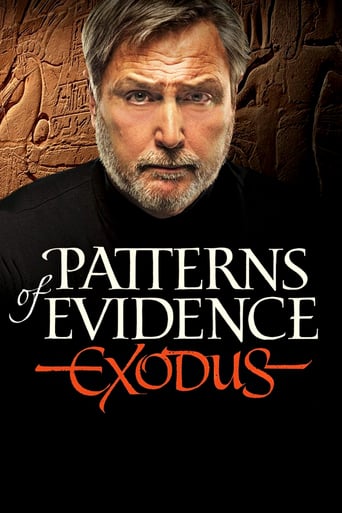

Ce documentaire est extrêmement bien documenté et sérieux, captivant passionnant...
... View MoreInsightful, even handed, restrained, and yet utterly compelling, Patterns of Evidence: The Exodus is an intelligent documentary and mature treatment of a very sensitive subject. It's a film that values exploration and questioning, rather than hand wringing and partisanship. It's a film of value, a film of questions, and one that can serve to better inform. As the documentary relates, the establishment view is that the Exodus didn't happen as described in the Bible, or is entirely fictional. This criticism seems to revolve around the established timeline for the Exodus. The documentary challenges this assumption, and does so convincingly. Experts of every stripe are shown, yet the film gives a notable voice to those who point to startling evidence of exactly what the Bible describes, just earlier than accepted. Director Tim Mahoney navigates the ensuing web well, keeping the viewer anchored with excellent visuals and a concise yet intelligent description off the correlation of events, and how they may fit from an archaeological standpoint.It's not perfect, some of the dramatization is unnecessary and the narration uneven, yet the questions poignant, and the execution striking.4/5 Stars
... View MoreI feel Netflix has let me down again. Why do they insist on giving us garbage like this. "Pattern's of Evidence"? There, the title should have given me pause. It should have been called "Quasi-Evidence" for the lack of real science. Listen, I would love to believe in Bigfoot or the Lock Ness Monster, but documentaries like these are simply a waste of time. Especially when the narrator says, "The Bible records....blah blah" or "Their antagonistic claims..." when describing books from Christopher Hitchens and Richard Dawkins. The Bible is not a book of record no more than Forrest Gump is a documentary. It's a book of faith, for those who cannot comprehend science. Books like "God is Not Great" simply use REASON to counter faith. Basically "Patterns of Evidence: The Exodus" is this: "Look, we have found some chicken bones next to a KFC. Perhaps the pharaohs were plagued by chickens sent from God!", then they show lame, dated, computer graphics and present them as conclusive evidence.What I do love about this film is it's pacing. It is so slow, that you know the target audience is the elderly and those who have no mind for education. I just picture a group of slow-witted, morons in a theater with their mouths open, drooling, and making sounds like cow getting a massage. I highly recommend this movie if you are having trouble sleeping.
... View MoreThis documentary provides astounding evidence of the events described in the book of Exodus, as well as key events in Genesis. Key events substantiated include:The existence of Joseph: -A canal which bears his name to this day which was a major achievement of agricultural planning and engineering; -A palatial residence in Goshen, belonging to a high ranking Egyptian official, built over a large Syrian-style home, in a district inhabited by Asiatic/Semitic people; -Joseph's tomb: adjacent to the palatial home, topped with a pyramid, surrounded by 11 other tombs in the same complex. The "Joseph tomb" features architecture reserved for pharaohs, queens, and other extremely high ranking Egyptian officials, contains no Egyptian religious objects, but does have a larger-than-life statue of a man who is portrayed as a northerner/Semitic man with distinct hairstyle and clothing, including the painted remnants of a "coat of many colors." The existence of a large population of Semitic persons in Egypt, populating the Delta region as the Bible specifies, apparently authorized directly by the pharaoh and/or his administration, comprising a distinct Semitic material culture, presence of herd animals in abundance (shepherd culture), which multiplied rapidly and was initially characterized by prosperity.Descent of Semitic population into poverty, impoverishment and short life expectancy, consistent with forced servitude.The occurrence of the Biblical plagues in Egypt, characterized by the sudden decline in Egypt's ability to defend itself, culminating in an effortless takeover by the "Hyksos" or "shepherd kings." An Egyptian document named the Ipuwer Papyrus details, with starting convergence to the Biblical account, a time in which Egypt suffered terrible plagues at the hands of "God" (singular), including thirst due to the Nile becoming "as blood," hunger and destitution in every social class in Egypt, death in every home, lamentation throughout the entire land, AND slaves plundering their former masters, with gold and jewels being worn around the necks of female slaves.Mahoney then cites archaeological evidence for the conquest of Canaan, in which all the cities claimed to have been destroyed in the book of Joshua, were in fact destroyed in the same exact manner. One striking piece of evidence is a tablet recovered from the ruins of Hazor, which references a king named Jabin--the exact name attributed to the king of Hazor (Jaban) by the book of Exodus! Other amazing correlations are found in the details of the destruction of the city of Jericho.All of this evidence taken in sum adds up to an exhaustively evidenced and coherent picture of major events described in Genesis, Exodus and the book of Joshua. The evidence is extremely compelling. The biggest impediment to a complete corroboration of the Biblical accounts is the discrepancies in dating that have plagued modern archaeological attempts to harmonize these events. These issues are complex and knotty, and well over the heads of most viewers, not to mention, very time-consuming to survey. In a rather understated way, Mahoney suggests that his own position is to agree with researchers like David Rohl that what is needed is a radical reassessment of Egyptian chronology. In my own reading and that of my husband, this view is well founded. Mahoney's goal at the end, it seems to me, is not to champion his own view of the harmonization of biblical accounts, history, and chronology, but to reveal the depth of archaeological evidence for the Exodus, give a brief introduction to varying views on how and where to place this event chronologically, and hope that his film will stimulate further interest, awareness and scholarship on the issue. I personally support, to my current knowledge on the subject, the redating route. To read more on this, I would recommend the works of Emmanuel Velikovsky: Ramses II and His Time (brilliantly illustrates a lot of the absurdities of conventional Egyptian chronology and dating) and Peoples of the Sea, in which he probes the question of who the Hyksos were. Another great work on the subject of chronological reassessment is Centuries of Darkness by Peter James.To conclude, I was highly impressed with this film and I can only hope Mahoney will direct a follow-up or even a series of films further probing issues of dating and other side issues of the Exodus. The end of the film was a bit disappointing just because of the lingering uncertainty as to dating with which Mahoney concluded, but I believe this was a very careful and reasonable tone to take with the subject matter. His main points were that there is a plethora of evidence archaeologically for these events occurring as described and that there are many and strong reasons to reassess conventional scholarship in terms of dating these events and even the wider chronologies of Egypt and the Near East. The first point was illustrated very brilliantly and persuasively; the second, I felt, a little less so, mostly due, I believe, to the heady nature of the evidence there and the lack of time to adequately cover such a subject. If this intrigues you, do your own reading! I also highly recommend the online articles of scholar Alan Montgomery, who has done absolutely brilliant work on Biblical, Egyptian and Near Eastern chronology. His view is that Kenyon's Jericho date of 1550 is indeed valid and that that is when the Conquest occurred, following a 1590 Exodus.I am thrilled that this documentary was produced and fervently hope that it will spark further debate, scholarship, and confidence on the part of believers of the Biblical accounts!
... View More